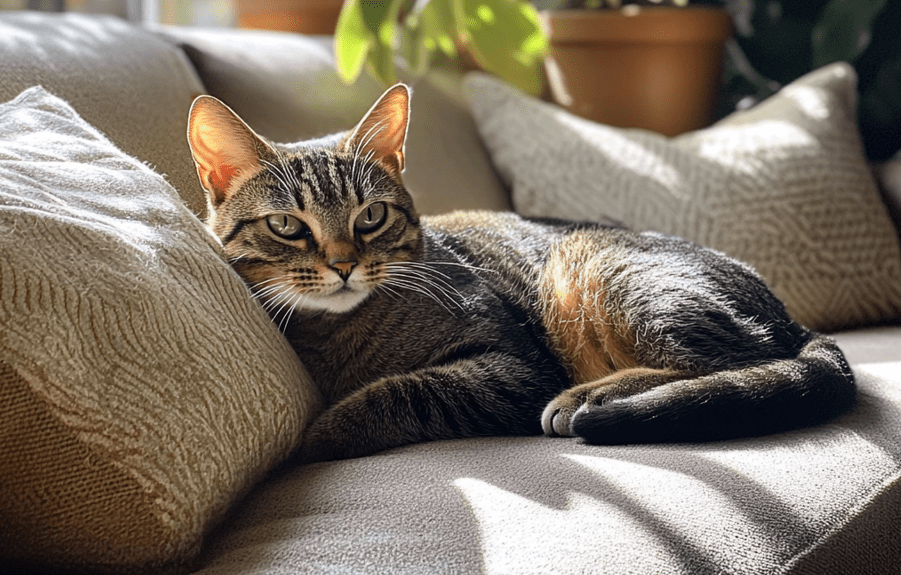
Itchy ears in Domestic Shorthairs can be a distressing issue for both cats and their owners. These beloved felines, known for their sleek coats and diverse personalities, often suffer from ear discomfort that leads to scratching, head shaking, or irritability. Identifying the root causes of itchy ears in Domestic Shorthairs is crucial for effective treatment and relief. This comprehensive guide explores the most common causes, from ear mites to allergies, and provides practical, vet-approved remedies to soothe your cat’s discomfort and restore their well-being.
Understanding Itchy Ears in Domestic Shorthairs
Domestic Shorthairs are prone to ear issues due to their sensitive skin and ear anatomy. Itchy ears can signal underlying health problems, ranging from minor irritations to serious infections. Persistent scratching or discomfort should never be ignored, as untreated ear issues can lead to complications like infections or hematomas. By recognizing the signs and causes, you can take swift action to help your cat feel better.
Signs of Itchy Ears
1.Excessive scratching or pawing at the ears
2.Head shaking or tilting
3.Redness, swelling, or warmth in the ear canal
4.Dark, waxy discharge or foul odor
5.Crusty or scabby skin around the ears
6.Behavioral changes, such as irritability or lethargy
If your Domestic Shorthair shows any of these symptoms, consult a veterinarian to determine the cause and appropriate treatment.
Common Causes of Itchy Ears in Domestic Shorthairs
Several factors can contribute to itchy ears in Domestic Shorthairs. Below are the most prevalent causes, along with insights into their symptoms and triggers.

1. Ear Mites
Ear mites (Otodectes cynotis) are tiny parasites that thrive in a cat’s ear canal, causing intense itching and irritation. They are highly contagious and common in kittens, outdoor cats, or multi-pet households.
Symptoms: Dark, coffee-ground-like discharge, excessive scratching, head shaking, and crusty ear edges.
Triggers: Contact with infected animals or contaminated environments.
Diagnosis: A vet will examine ear debris under a microscope to confirm mites.
2. Allergies
Allergies, whether environmental, food-related, or flea-induced, are a leading cause of itchy ears in Domestic Shorthairs. Allergens irritate the skin, leading to inflammation and discomfort.
Types of Allergies:
Environmental: Pollen, dust mites, or mold.
Food: Proteins like chicken, beef, or grains.
Flea Allergy Dermatitis: Sensitivity to flea saliva.
Symptoms: Red, itchy ears, skin rashes, hair loss, and generalized scratching.
Triggers: Exposure to allergens or flea infestations.
Diagnosis: Allergy testing, elimination diets, or flea control assessments.
3. Yeast or Bacterial Infections
Infections often develop as secondary issues due to allergies, ear mites, or excessive moisture in the ear canal. Yeast and bacteria thrive in warm, moist environments, causing inflammation and itching.
Symptoms: Foul odor, yellow or black discharge, redness, and swelling.
Triggers: Poor ear hygiene, allergies, or trapped moisture from bathing or swimming.
Diagnosis: A vet will take an ear swab for microscopic analysis or culture.
4. Ear Wax Buildup
Excessive ear wax can trap debris, irritate the ear canal, and cause itching. While some wax is normal, Domestic Shorthairs with narrow ear canals may be prone to buildup.
Symptoms: Waxy debris, mild itching, and occasional head shaking.
Triggers: Lack of regular ear cleaning or anatomical predisposition.
Diagnosis: Visual inspection by a vet.
5. Foreign Bodies
Grass seeds, dirt, or other debris can lodge in the ear canal, causing irritation and itching. Outdoor Domestic Shorthairs are particularly at risk.
Symptoms: Sudden onset of itching, head tilting, or pain when the ear is touched.
Triggers: Exploring grassy or dusty environments.
Diagnosis: A vet will use an otoscope to inspect the ear canal.
6. Polyps or Growths
Non-cancerous growths, such as polyps, can develop in the ear canal, leading to irritation and itching. These are less common but require prompt attention.
Symptoms: Persistent itching, head tilting, or discharge.
Triggers: Chronic inflammation or genetic predisposition.
Diagnosis: Imaging or biopsy to evaluate the growth.
7. Skin Conditions
Skin disorders like dermatitis or seborrhea can affect the ears, causing itching and flaking. These conditions may be linked to allergies or hormonal imbalances.
Symptoms: Dry, scaly skin, redness, or greasy ear tissue.
Triggers: Allergies, poor grooming, or underlying health issues.
Diagnosis: Skin scrapings or blood tests to identify the cause.
Vet-Approved Remedies for Itchy Ears
Treating itchy ears in Domestic Shorthairs requires addressing the underlying cause while providing symptom relief. Always consult a veterinarian before starting any treatment to ensure safety and effectiveness.

1. Treating Ear Mites
Medication: Prescription ear drops or topical treatments (e.g., selamectin or ivermectin) eliminate mites. Treatment typically lasts 2–4 weeks.
Cleaning: Use a vet-recommended ear cleaner to remove debris before applying medication.
Environmental Control: Wash bedding, vacuum carpets, and treat other pets to prevent reinfestation.
Follow-Up: Regular vet checkups ensure the mites are fully eradicated.
2. Managing Allergies
Flea Control: Use vet-approved flea preventatives (e.g., topical or oral treatments) to eliminate fleas and prevent allergic reactions.
Elimination Diet: Work with your vet to identify food allergens by switching to a hypoallergenic or novel-protein diet for 8–12 weeks.
Antihistamines or Steroids: Prescription medications can reduce itching and inflammation caused by environmental allergies.
Allergen Avoidance: Minimize exposure to pollen or dust by keeping windows closed and using air purifiers.
3. Treating Infections
Antibiotics or Antifungals: Prescription ear drops or oral medications target bacterial or yeast infections. Treatment may last 1–4 weeks.
Ear Cleaning: Regular cleaning with a vet-approved solution prevents debris buildup and supports healing.
Underlying Cause: Address allergies or moisture issues to prevent recurrence.
Monitoring: Follow up with your vet to confirm the infection is resolved.
4. Removing Ear Wax Buildup
Ear Cleaning: Use a vet-recommended ear cleaner and cotton balls to gently remove wax. Never use cotton swabs, which can push debris deeper.
Frequency: Clean your cat’s ears every 1–2 weeks, or as advised by your vet.
Professional Cleaning: For severe buildup, a vet may perform a thorough ear flush under sedation.
5. Removing Foreign Bodies
Veterinary Removal: A vet will use specialized tools to safely extract debris, often under sedation to minimize stress.
Pain Management: Anti-inflammatory medications may be prescribed to reduce discomfort.
Prevention: Limit outdoor exploration in grassy areas during seed season.
6. Addressing Polyps or Growths
Surgical Removal: Polyps often require surgical extraction, performed under anesthesia.
Biopsy: A sample may be tested to rule out malignancy.
Post-Operative Care: Administer prescribed medications and keep the ear clean to promote healing.
7. Managing Skin Conditions
Medicated Shampoos: Use vet-prescribed shampoos to treat dermatitis or seborrhea affecting the ears.
Supplements: Omega-3 fatty acids can support skin health and reduce inflammation.
Underlying Cause: Treat allergies or hormonal issues to prevent recurrence.
At-Home Care and Prevention
While veterinary treatment is essential, at-home care can support your Domestic Shorthair’s ear health and prevent future issues.
1. Regular Ear Cleaning
How to Clean: Use a vet-approved ear cleaner. Gently massage the base of the ear, then wipe away debris with a cotton ball.
Frequency: Clean every 1–2 weeks, or as recommended by your vet.
Caution: Avoid over-cleaning, which can irritate the ear canal.
2. Monitor for Symptoms
Check your cat’s ears weekly for redness, discharge, or odor. Early detection allows for prompt treatment and prevents complications.
3. Maintain a Clean Environment
1.Wash bedding regularly to reduce dust and allergens.
2.Vacuum carpets and furniture to minimize flea eggs and environmental irritants.
3.Use hypoallergenic grooming products to avoid skin sensitivities.
4. Support Overall Health
Diet: Feed a balanced, high-quality diet to support skin and immune health.
Hydration: Ensure access to fresh water to prevent dry skin.
Grooming: Regular brushing reduces debris and distributes natural oils.
5. Flea Prevention
Apply vet-approved flea preventatives year-round, even for indoor cats, to prevent flea allergy dermatitis.
When to See a Veterinarian
While mild ear itching may resolve with at-home care, certain signs warrant immediate veterinary attention:
1.Persistent scratching or head shaking lasting more than a few days
2.Foul odor, discharge, or blood from the ears
3.Swelling, pain, or heat in the ear area
4.Behavioral changes, such as aggression or lethargy
5.Asymmetry, such as head tilting or one-sided symptoms
A veterinarian will perform a thorough exam, which may include otoscopy, microscopy, or allergy testing, to diagnose the issue accurately.
Conclusion

Itchy ears in Domestic Shorthairs are a common but manageable issue when addressed promptly. By understanding the causes—ear mites, allergies, infections, and more—you can take targeted steps to relieve your cat’s discomfort. Veterinary care, combined with at-home remedies and preventive measures, ensures your Domestic Shorthair enjoys healthy, itch-free ears. Always consult a veterinarian for persistent or severe symptoms to safeguard your cat’s health.
For personalized advice, schedule a vet visit or consult a feline specialist. With the right care, your Domestic Shorthair can live comfortably and happily, free from the irritation of itchy ears.




